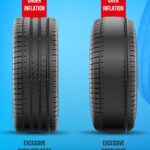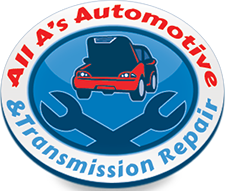Auto Stability | Inspection Triangle Part 2

 This blog series will explore why many mechanics and auto shops believe in the Auto Inspection Triangle concept. An Auto Inspection Triangle focuses on three areas of your vehicle that work together equally. The legs of the Auto Inspection Triangle are called Stability, Steering, and Stopping. In part 2 of this series, we will discuss how your vehicle’s tires, tread, and suspension system contribute to Auto Stability.
This blog series will explore why many mechanics and auto shops believe in the Auto Inspection Triangle concept. An Auto Inspection Triangle focuses on three areas of your vehicle that work together equally. The legs of the Auto Inspection Triangle are called Stability, Steering, and Stopping. In part 2 of this series, we will discuss how your vehicle’s tires, tread, and suspension system contribute to Auto Stability.
What is Auto Stability?
The Stability side of the Auto Inspection Triangle focuses on the components that work together to increase traction and reduce weight transfer. Your vehicle utilizes the shocks, struts, and tires together as a team to achieve stability. When one or more of these components becomes worn or damaged, the Stability leg of the triangle is compromised.
Tire Safety and Auto Stability
Tires provide stability through traction during acceleration, braking, and cornering. When properly inflated, tires also absorb small bumps. Performing routine maintenance on your vehicle’s tires and suspension system will improve auto stability. Remember, a single worn or damaged part can negatively affect your vehicle’s overall safety.
Signs Of Wear
Tires wear over time and with regular use. Road debris and UV rays can damage tires, as well as deterioration from aging rubber. Auto experts recommend performing a visual inspection of your tires about once a week. Look for cracks, low tread, bulges, and unusual tread wear.
Tire Inspection
You can learn many things from a detailed inspection of your tires. In addition, there are markings & codes on the sidewall of each tire that provide specific information, like the tire’s size, maximum pressure, and traction rating.
Tire Maintenance
Proper tire maintenance should include frequent visual inspections, air pressure checks with a quality digital gauge, and routine service as outlined in your owner’s manual. Furthermore, most vehicles should have a tire rotation every 5,000 – 8,000-miles.
New Tire Purchase
Manufacturers mark all their tires with a tire creation date. According to most experts, the service life of a tire is generally six to ten years. Therefore, when it’s time to buy new tires, be sure that the tire manufacture date is recent. You never want to purchase tires that have been sitting on the showroom floor for years.
Troubleshooting Tread Wear
Uneven tread wear can be a symptom of a more significant issue impacting your vehicle’s safety and stability.
- Cupping or Scalloping means that rubber pieces are gouged-out or missing from the tread and may be a sign of worn Shocks & Struts.
- Feathering or angled tread wear can signify misalignment or worn suspension.
- Excessive tread wear on one edge can indicate an alignment issue.
- Thin center tread happens when tires are overinflated.
- Thin tread on both edges of the tire occurs when tires are under-inflated.
- Flat spots & patchy tread wear may be symptomatic of the vehicle’s wheels being out-of-balance or faulty shocks.
Tire Pressure
Maintaining the correct tire pressure is essential for extending the life of your tires and achieving the best possible stability for your automobile. Follow the manufacturer’s suggested tire pressure for your vehicle’s tires. Inspect your tire pressure when outside temperatures change over 15 degrees. Tire pressure can change dramatically with swings in the weather.
Tire Balancing
Properly balanced tires help reduce uneven tread wear and extend tire service life. When a service technician balances your tires, they attach small weights to the wheels, which limits tire vibrations as the wheels turn. Whenever you purchase new tires, the technician should balance them.
Wheel Alignment
Wheel alignment is the precise measurement or position of all the wheels in relation to each other and the ground. Every vehicle has factory-recommended wheel alignment settings. Vehicle stability may diminish when wheel alignment measurements are out of alignment, and uneven tire tread wear can occur.
Suspension System and Auto Stability
Modern vehicle suspension systems must support the vehicle, deliver safe handling, and provide optimum traction in various road conditions. Additionally, the suspension system components must absorb bumps to provide a comfortable ride quality. While each suspension part works independently, collectively, they contribute to the performance and stability of the entire system. If one component is worn or damaged, it can contribute to the failure of other parts in your vehicle. The design of suspension systems varies widely from vehicle to vehicle, but most of them include the following components:
- Springs: Springs absorb bumps and rough road conditions.
- Shocks & Struts: Shock absorbers (or Struts) dampen the motion of the springs, preventing the vehicle from excessive movement. Shocks and Struts contain thick oil which can leak due to wear, a crash, or improper maintenance. Shocks or Struts that leak or are out of oil can fail and must be replaced.
- Bushings & Bearings: Bushings and bearings are connections that permit a small amount of twisting or sliding (usually without lubrication)
- Tie Rods & Joints: Tie rods are lubricated joints that connect to steering linkage components. Joints may use grease to aid in movement.
- Tires: The tires are the keystone to the suspension system. They are in contact with the road and connect to all the subsequent suspension components.
Auto Stability Inspection in Midland, MI
We offer complete automotive services for foreign & domestic automobiles at All A’s Automotive & Transmission Repair in Midland, MI. Call us when your vehicle needs a diagnostic service to improve auto stability or address safety issues with your tires and suspension. Our experienced technicians will work hard to find the right solution for your needs.
Schedule Service
Ask your service technician about the Auto Inspection Triangle each time you bring your vehicle in for tires, brakes, suspension, or steering services. Call us at (989) 631-4672 or make your appointment online.
Previous Blog – Auto Inspection Triangle Part 1 | Overview
Read Part 1 for an overview of the Auto Inspection Triangle. Find out what it is, how it works, and why it’s essential for the safety of your vehicle.
Next Blog – Auto Steering | Inspection Triangle Part 3
In part 3 of this blog series, we will focus on the Steering side of the Auto Inspection Triangle. Including the specific components that affect your vehicle’s steering and ways to troubleshoot possible issues. Plus, we will cover factory-suggested service intervals that can help keep your automobile operating safer.
Posted in: Tires & Wheels, Wheel Alignment
Leave a Comment (0) ↓
